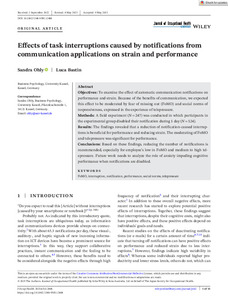Effects of task interruptions caused by notifications from communication applications on strain and performance
| dc.date.accessioned | 2023-11-09T10:38:15Z | |
| dc.date.available | 2023-11-09T10:38:15Z | |
| dc.date.issued | 2023-06-06 | |
| dc.identifier | doi:10.17170/kobra-202311098988 | |
| dc.identifier.uri | http://hdl.handle.net/123456789/15166 | |
| dc.description.sponsorship | Gefördert durch den Publikationsfonds der Universität Kassel | ger |
| dc.language.iso | eng | |
| dc.rights | Attribution-NonCommercial-NoDerivatives 4.0 International | * |
| dc.rights.uri | http://creativecommons.org/licenses/by-nc-nd/4.0/ | * |
| dc.subject | FoMO | eng |
| dc.subject | interruption | eng |
| dc.subject | notification | eng |
| dc.subject | performance | eng |
| dc.subject | social norms | eng |
| dc.subject | telepressure | eng |
| dc.subject.ddc | 150 | |
| dc.title | Effects of task interruptions caused by notifications from communication applications on strain and performance | eng |
| dc.type | Aufsatz | |
| dcterms.abstract | Objectives: To examine the effect of automatic communication notifications on performance and strain. Because of the benefits of communication, we expected this effect to be moderated by fear of missing out (FoMO) and social norms of responsiveness, expressed in the experience of telepressure. Methods: A field experiment (N = 247) was conducted in which participants in the experimental group disabled their notification during 1 day (N = 124). Results: The findings revealed that a reduction of notification-caused interruptions is beneficial for performance and reducing strain. The moderating of FoMO and telepressure was significant for performance. Conclusions: Based on these findings, reducing the number of notifications is recommended, especially for employee's low in FoMO and medium to high telepressure. Future work needs to analyze the role of anxiety impeding cognitive performance when notifications are disabled. | eng |
| dcterms.accessRights | open access | |
| dcterms.creator | Ohly, Sandra | |
| dcterms.creator | Bastin, Luca | |
| dcterms.extent | 15 Seiten | |
| dc.relation.doi | doi:10.1002/1348-9585.12408 | |
| dc.subject.swd | Fear of missing out | eng |
| dc.subject.swd | Soziale Norm | |
| dc.subject.swd | Leistung | |
| dc.subject.swd | Kommunikation | |
| dc.type.version | publishedVersion | |
| dcterms.source.identifier | eissn:1348-9585 | |
| dcterms.source.issue | Issue 1 | |
| dcterms.source.journal | Journal of Occupational Health | eng |
| dcterms.source.volume | Volume 65 | |
| kup.iskup | false | |
| dcterms.source.articlenumber | e12408 |
Files in this item
This item appears in the following Collection(s)
-
Artikel [1106]


